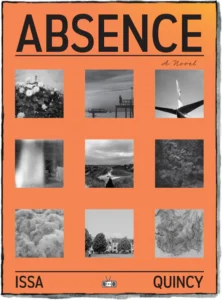
[Two Dollar Radio; 2025]
How does one write a novel about things that are not there? About the missing, the lost, the absent? Or is this the only kind of writing there is? British writer Issa Quincy’s debut novel, Absence, takes up these questions. It asks us to consider what used to be present but has faded away, leaving ghostly traces and a glimmer of the possibility of return. The novel gestures toward the emptiness at the heart of language itself.
Absence is a short novel, barely longer than a novella, that consists of six loosely connected sections, each of which introduces a new story, setting, era, and cast of characters. Themes of loss, memory, and the haunting of history unite the stories, as does the unnamed, first-person narrator, who is consistently present as the novel’s meditative, ruminative voice, but who reveals little about himself, and from the opening pages seems on the point of disappearing:
At times it felt like the world had its own sly way of reminding me who I was, from when it was I had first walked, even as I dispersed further into nobody at all, into nothing more than a voice without a vessel silently drifting through old images, memories, voices and histories…
As in Rachel Cusk’s Outline trilogy, W.G. Sebald’s The Rings of Saturn, and Kate Zambreno’s Drifts, the narrator of Absence quickly cedes attention to other people’s voices and stories. In the novel’s opening paragraphs, we glimpse the narrator as he remembers his mother reciting her favorite poem. He then shifts into recounting the lives of others, returning only occasionally with a few facts about himself, little pieces of family history and childhood memory. Then he leaves again, guiding us into another story, and then frequently to stories within stories, which are often told in someone else’s voice or through letters and emails. He writes from a first-person omniscient point of view, able to report on characters’ thoughts it seems he shouldn’t have access to and details it’s implausible he would remember.
From the opening memories of the narrator’s mother and her favorite poem (Oscar Wilde’s “The Ballad of Reading Gaol,” written to protest harsh prison conditions after Wilde’s imprisonment for “gross indecency,” or homosexual acts), the narrator shifts to a story of a childhood teacher who suddenly and mysteriously left his teaching position. We hear of how he was harmed as a child and in turn harmed others as an adult. Moving through the six sections, the narrator recounts tales of people he met while living with his grandmother in the United States, of his London landlord and this landlord’s family, of his godfather as a child, of a woman his father knew in Tunisia, and of a family friend’s regular visits to Cyprus.
As different as the people and places in each story are, echoes and variations among them proliferate. Stories of loss repeat — the narrator’s parents, other lost or estranged parents and children, the loss of love and freedom. Stories of return repeat as well. Memories float back into the mind, the narrator hears his mother’s favorite poem again, names recur, and photographs and notebooks reappear.
Missing or estranged family members abound. Shortly after the narrator mentions the death of his mother, his teacher, Mr. Rothlan, describes a childhood memory of seeing a boy thrown off a ship to his death. The mother’s grief haunts Mr. Rothlan his whole life. In the next section, the narrator’s friend Patricia tells him he reminds her of her son, with whom she doesn’t speak. She never explains why. Later still, we meet Sulli whose family decided he should be hidden away after a childhood accident led to his erratic behavior and speech. Now Sulli is the narrator’s landlord and the two become friends. Sulli tells the story of his aunt Jedha, also ejected from their family after she came out as a lesbian.
Names come in patterns as well. Patrick/Patricia appear multiple times across several stories. The boy Mr. Rothlan witnessed drowning has the same name as one of his students. Mr. Rothlan and a friend named Gilles discuss a philosopher whom we know is Gilles Deleuze. These friends discuss Deleuze’s suicide, and later Gilles discovers Mr. Rothlan has died by suicide as well. These repetitions provide unity to a text that might otherwise feel disjointed, and they create a sense of mystery, hinting at levels of connection that defy everyday experience.
Typical of the book’s patterns is a scene in which Sulli laughs about the tale of the “dead ass,” in Laurence Sterne’s 1768 novel, A Sentimental Journey Through France and Italy. In this novel, Sterne’s protagonist, Yorick, meets a man mourning the loss of his donkey, which has become the man’s companion and friend. The story is ridiculous — it’s an occasion for Sterne to make a scatological joke about asses — and also charged with genuine emotion, as the donkey’s death provokes tears and deep sadness. Sulli laughs so hard at this story, he can’t even finish telling it, but underneath that hysterical laughter lies the sorrow of loss and abandonment.
Another Sterne allusion, less direct but just as illuminating, appears a page after Sulli’s laughter when we learn “he tended to return to his melancholic refrain, I only want to be free.” Sulli is echoing Yorick’s encounter with a caged starling who repeats, “I can’t get out—I can’t get out.” In A Sentimental Journey, the bird’s words provoke Yorick’s extended meditation on imprisonment and slavery and how precious freedom is. In Absence, the narrator says, “It was in those moments that Sulli appeared to me as caged and confined, as constricted and alone as he truly was.” Sulli is trapped, as is his aunt Jedha, who we learn is confined in a psychiatric hospital. Both characters suffer in the cage of their culture’s homophobia; Jedha never recovers from her family’s rejection, and Sulli becomes free enough to find love with another man only years after the narrator knew him. Other characters are trapped in tower apartments or left sick in houses to fend for themselves. Oscar Wilde’s poem of imprisonment hovers over the novel, reminding us of the harshness of prison life.
In the midst of these images of confinement, the narrator is in some ways remarkably free. He is able to tell us of Sulli, for example, that “In that moment, as he had done many times before, he felt a deep tension twang between him and his aunt Jedha like they were conjoined across time, space, and death….” It could be that Sulli has told him about this feeling, he’s making an informed guess, or he’s making it up, but similar instances of omniscience regularly occur throughout the novel. The care and the feeling with which the narrator recounts this story and others point more toward a mysterious understanding or a blurring of the boundaries among them than a false presumption of knowledge. Somehow the narrator is all these people, and they are him, while every person is, still, only themselves. As a character writes in a journal entry, “The sight of oneself was like beholding a single grain of sand dissolving on a seabed.” The grain of sand exists but also dissolves; it is part of the seabed, nearly indistinguishable from it, but not quite.
It’s unclear what time or place the narrator speaks from. On the first page, as he calls up his mother’s memory: “It is with her there, so many years past now, I am reminded of who I was before I myself disappeared.” The nature of this disappearance remains unresolved. Has he retreated from life to live in isolation? Is he describing how he has changed over time? Is he speaking from the grave?
But these questions are also beside the point. Instead, the novel’s concern is finding language to express an open, unbounded sense of identity. It offers a capacious vision of the self, one at odds with the traditional novelistic project of creating and defining a protagonist with clear attributes and boundaries, with a will he projects out into the world. Instead, Quincy’s narrator merges with the lives, landscapes, and stories around him. Towards the end of the novel, the narrator says of an old friend Daphne:
In that moment, I saw her as a little girl, who when she talked had to shake her head to still her thoughts, and who knew the stories so well of her mother, and of her father. The same such stories that, over the years, have proliferated in me, and latched onto me; ones, as happens sometimes, that I cannot year myself from; I cannot escape, no, they remain, even now, tangled in me…
The narrator is possessed by Daphne’s stories just as much as she is. They are alive and growing and bind the two people together, so that the stories belong to neither one but live in the space between them and within them. Everything is a tangle.
The novel’s second section offers another image to describe its narrator. Here, he remembers looking at a painting by Hendrick Avercamp, a Dutch landscape painter of the early seventeenth century, and at first only noticing a simple winter scene. Upon further thought, he realizes that everything in the painting, “death, pleasure, ecstasy, frivolity, poverty and secrecy,” is “perceived by Avercamp from a heightened position, a vantage point for an incorporeal observer,” so that what is presented “is the sight of the intangible spectator that sees what is in front of him, recognizes everything and curtails his judgement of anything.” The narrator is that observer, both incorporeal and intangible, and capable of deep insight with no need to draw conclusions or judge.
The narrator uses this sharpness of vision to bring into focus lives that otherwise would fade into oblivion. He resists absence even while he himself blends into the background. The towers outside Boston that haunted him as a child turn out to be where his friend Patricia lives, who says of them, “that’s what this place was and the people who lived in it—unseen.” Patricia describes a murder that took place outside her building that she is upset that nobody noticed or avenged. But the narrator is there to observe and record her presence so that a record lives on. Similarly, Sulli’s aunt Jedha writes, “Maybe, as I have come to think, I am gone in other’s minds and in the world, and as that is, I don’t truly exist anymore. I have been forgotten.” But the narrator knows, and we know, that she existed and is remembered.
Ultimately, though, all this remembering and recording occurs in language, and Quincy’s novel is about how language, too, generates its own form of absence. A character argues that “words are never enough to understand the entirety of a thing: pieces are left out or forgotten and the weight and intensity of the reality pales under the infirmity of words.” Later, the narrator thinks, “the knowable would forever remain unknowable and the sayable would forever remain pale, ghostlike, evasive.” This is the paradox at the heart of the novel: even what we know and say, the words we put into print, the stories we rescue from oblivion, are at heart little more than ghosts, pointing toward a reality that forever eludes them. The best the narrator can do is gesture toward the world — all the places, objects, and people that have made him who he is — knowing that this gesture is futile at the same time as it is full of love.
Rebecca Hussey is a teacher, writer, and critic living in Connecticut. She is on the board of the National Book Critics Circle and serves as Vice President of Technology and Membership. Her writing has appeared in Words Without Borders, The Kenyon Review, Atmospheric Quarterly, The Rumpus, and more. She is a co-host of the One Bright Book podcast and author of the Substack newsletters Reading Indie and #KateBriggs24. She can be found at @ofbooksandbikes on Bluesky and Instagram.
This post may contain affiliate links.







